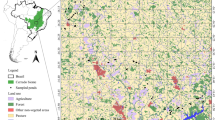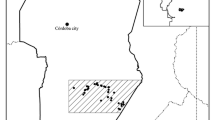Abstract
Context
Competitive interactions potentially play an important role in structuring bird communities. It is unclear how differences in functional traits influence the niche dimensions of highly mobile waterbird species, particularly when they co-exist in spatiotemporally heterogeneous communities.
Objectives
We investigated the inter-relationships between waterbird trait groupings (movement, dietary and foraging habitat) and environmental variable groupings (rainfall, land cover, vegetation structure and water quality). Specifically, we tested whether the scale of environmental variables filtered movement traits and whether these traits operated in conjunction with dietary and foraging habitat traits to form distinct ecological niches in waterbirds.
Methods
We conducted waterbird and environmental variable surveys in 60 sites, sampled seven times each at bimonthly intervals, in KwaZulu-Natal, South Africa. Trait-environment relationships were tested using a combination of RLQ and fourth-corner analyses.
Results
Several significant trait-environment relationships emerged in bivariate correlations and multivariate ordination space. Movement traits correlated with the scale of environmental variables; migrant and nomadic species responded to broad scale environmental variables. Vegetation structure and land cover were particularly important in explaining the abundance of species foraging in emergent vegetation. Three groups emerged along a gradient in multivariate ordination space providing evidence for ecological niche separation of waterbirds with different movement traits.
Conclusions
Our findings suggest that the scale of landscape resources can act as a filter of movement traits, and that in conjunction with dietary and foraging traits, waterbirds with different movement traits occupy distinct ecological niches.




Similar content being viewed by others
References
Alerstam T, Hedenstrom A, Akesson S (2003) Long-distance migration: evolution and determinants. Oikos 103:247–260
Austin GE, Rehfisch MM (2005) Shifting nonbreeding distributions of migratory fauna in relation to climatic change. Glob Change Biol 11:31–38
Balcombe CK, Anderson JT, Fortney RH, Kordek WS (2005) Vegetation, invertebrate, and wildlife community rankings and habitat analysis of mitigation wetlands in West Virginia. Wetl Ecol Manag 13:517–530
Benjamini Y, Hochberg Y (1995) Controlling the false discovery rate: a practical and powerful approach to multiple testing. J R Stat Soc Ser B 57:289–300
Boyle WA, Conway CJ, Bronstein JL (2011) Why do some, but not all, tropical birds migrate? A comparative study of diet breadth and fruit preference. Evol Ecol 25:219–236
Burger J (1986) The effect of human activity on shorebirds in two coastal bays in northeastern United States. Environ Conserv 13:123–130
Coetzee JA, Hill MP (2012) The role of eutrophication in the biological control of water hyacinth, Eichhornia crassipes, in South Africa. Biocontrol 57:247–261
Cottenie K (2005) Integrating environmental and spatial processes in ecological community dynamics. Ecol Lett 8:1175–1182
Cumming GS, Paxton M, King J, Beuster H (2012) Foraging guild membership explains variation in waterbird responses to the hydrological regime of an arid-region flood-pulse river in Namibia. Freshw Biol 57:1202–1213
Dolédec S, Chessel D, ter Braak CJF, Champely S (1996) Matching species traits to environmental variables: a new three-table ordination method. Environ Ecol Stat 3:143–166
Dray S, Chessel D, Thioulouse J (2003) Co-inertia analysis and the linking of ecological data tables. Ecology 84:3078–3089
Dray S, Choler P, Dolédec S, Peres-Neto PR, Thuiller W, Pavoine S, ter Braak CJ (2014) Combining the fourth-corner and the RLQ methods for assessing trait responses to environmental variation. Ecology 95:14–21
Dray S, Dufour AB (2007) The ade4 package: implementing the duality diagram for ecologists. J Stat Softw 22:1–20
Dray S, Legendre P (2008) Testing the species traits-environment relationships: the fourth-corner problem revisited. Ecology 89:3400–3412
Eros T, Sály P, Takács P, Specziár A, Bíró P (2012) Temporal variability in the spatial and environmental determinants of functional metacommunity organization—stream fish in a human-modified landscape. Freshw Biol 57:1914–1928
Ezemvelo KZN Wildlife (2011) KwaZulu-Natal Land Cover 2008 V1.1. Unpublished GIS Coverage [Clp_KZN_2008_LC_V1_1_grid_w31.zip], Biodiversity Conservation Planning Division, Ezemvelo KZN Wildlife
Gotelli NJ, Graves GR, Rahbek C (2010) Macroecological signals of species interactions in the Danish avifauna. Proc Natl Acad Sci USA 107:5030–5035
Greenberg R (1995) Insectivorous migratory birds in tropical ecosystems: the breeding currency hypothesis. J Avian Biol 26:260–264
Hill MP (2003) The impact and control of alien aquatic vegetation in South African aquatic ecosystems. Afr J Aquat Sci 28:19–24
Hockey PAR, Dean WRJ, Ryan P (2005) Roberts birds of Southern Africa, 7th edn. Trustees of the John Voelcker Bird Book Fund, Cape Town
Hockey PAR, Douie C (1995) Waders of Southern Africa. Struik, Winchester
Hornung JP, Foote AL (2006) Aquatic invertebrate responses to fish presence and vegetation complexity in western boreal wetlands, with implications for waterbird productivity. Wetlands 26:1–12
Ikin K, Barton PS, Stirnemann IA, Stein JR, Michael D, Crane M, Okada S, Lindenmayer DB (2014) Multi-scale associations between vegetation cover and woodland bird communities across a large agricultural region. PLoS One 9:1–12
Ikin K, Knight E, Lindenmayer DB, Fischer J, Manning AD (2012) Linking bird species traits to vegetation characteristics in a future urban development zone: implications for urban planning. Urban Ecosyst 15:961–977
Jedlicka JA, Greenberg R, Perfecto I, Philpott SM, Dietsch TV et al (2006) Seasonal shift in the foraging niche of a tropical avian resident: resource competition at work? J Trop Ecol 22:385–395
Johnson DN, Maclean GL (1994) Altitudinal migration in Natal. Ostrich 65:86–94
Johnson M, Sherry T (2005) Migrants in Neotropical bird communities: an assessment of the breeding currency hypothesis. J Anim Ecol 74:333–341
Joseph L, Stockwell D (2000) Temperature-based models of the migration of Swainson’s Flycatcher (Myiarchus swainsoni) across South America: a new use for museum specimens of migratory birds. Proc Acad Nat Sci Phila 150:293–300
Kingsford R, Roshier D, Porter J (2010) Australian waterbirds—time and space travellers in dynamic desert landscapes. Mar Freshw Res 61:875–884
Legendre P, Galzin R, Harmelin-Vivien M (1997) Relating behavior to habitat. Solutions to the fourth-corner problem. Ecology 78:547–562
Levin SA (1992) The problem of pattern and scale in ecology: the Robert H. MacArthur award lecture. Ecology 73:1943–1967
McGill BJ, Enquist BJ, Weiher E, Westoby M (2006) Rebuilding community ecology from functional traits. Trends Ecol Evol 21:178–185
Mettke-Hofmann C, Gwinner E (2004) Differential assessment of environmental information in a migratory and a nonmigratory passerine. Anim Behav 68:1079–1086
Morrison CA, Robinson RA, Clark JA, Risely K, Gill JA (2013) Recent population declines in Afro-Palaearctic migratory birds: the influence of breeding and non-breeding seasons. Divers Distrib 19:1051–1058
Nakazawa Y, Peterson AT, Martínez-Meyer E, Navarro-Sigüenza AG (2004) Seasonal niches of Nearctic-Neotropical migratory birds: implications for the evolution of migration. Auk 121:610–618
Nicholson SE, Entekhabi D (1987) Rainfall variability in equatorial and southern Africa: relationships with sea surface temperatures along the southwestern coast of Africa. J Clim Appl Meteorol 26:561–578
Özkan K, Svenning JC, Jeppesen E (2013) Environmental species sorting dominates forest-bird community assembly across scales. J Anim Ecol 82:266–274
Pearman PB (2002) The scale of community structure: habitat variation and avian guilds in tropical forest understory. Ecol Monogr 72:19–39
Pérez-Tris J, Tellería JL (2002) Migratory and sedentary blackcaps in sympatric non-breeding grounds: implications for the evolution of avian migration. J Anim Ecol 71:211–224
Pfister C, Harrington BA, Lavine M (1992) The impact of human disturbance on shorebirds at a migration staging area. Biol Conserv 60:115–126
Piersma T, Lindström Å (2004) Migrating shorebirds as integrative sentinels of global environmental change. Ibis (Lond 1859) 146:61–69
Rodgers JAJ, Schwikert ST (2002) Buffer-zone distances to protect foraging and loafing waterbirds from disturbance by personal watercraft and outboard-powered boats. Conserv Biol 16:216–224
Russell IA, Randall RM, Randall BM, Hanekom N (2009) Relationships between the biomass of waterfowl and submerged macrophytes in a South African estuarine lake system. Ostrich 80:35–41
Salewski V, Bairlein F, Leisler B (2003) Niche partitioning of two Palearctic passerine migrants with Afrotropical residents in their West African winter quarters. Behav Ecol 14:493–502
Salewski V, Jones P (2006) Palearctic passerines in Afrotropical environments: a review. J Ornithol 147:192–201
Sanderson FJ, Donald PF, Pain DJ et al (2006) Long-term population declines in Afro-Palearctic migrant birds. Biol Conserv 131:93–105
Sarneel JM, Geurts JJM, Beltman B, Lamers LP, Nijzink MM, Soons MB, Verhoeven JT (2010) The effect of nutrient enrichment of either the bank or the surface water on shoreline vegetation and decomposition. Ecosystems 13:1275–1286
Seymour CL, Dean WRJ (2010) The influence of changes in habitat structure on the species composition of bird assemblages in the southern Kalahari. Austral Ecol 35:581–592
Siegfried W (1970) Wildfowl distribution, conservation and research in southern Africa. Wildfowl 21:89–98
Smith YCE, Smith DAE, Seymour CL, Thébault E, van Veen FF (2015) Response of avian diversity to habitat modification can be predicted from life-history traits and ecological attributes. Landsc Ecol. doi:10.1007/s10980-015-0172-x
Stankowich T, Blumstein DT (2005) Fear in animals: a meta-analysis and review of risk assessment. Proc R Soc Lond B 272:2627–2634
Studds CE, Marra PP (2005) Nonbreeding habitat occupancy and population processes: an upgrade experiment with a migratory bird. Ecology 86:2380–2385
Terörde AI, Turpie JK (2013) Influence of habitat structure and mouth dynamics on avifauna of intermittently-open estuaries: a study of four small South African estuaries. Estuar Coast Shelf Sci 125:10–19
Tyson PB, Preston-Whyte RA (2000) The weather and climate of southern Africa. Oxford University Press, Oxford
Wiescher PT, Pearce-Duvet JMC, Feener DH (2012) Assembling an ant community: species functional traits reflect environmental filtering. Oecologia 169:1063–1074
Winkler DW, Jørgensen C, Both C, Houston AI, McNamara JM, Levey DJ, Partecke J, Fudickar A, Kacelnik A, Roshier D, Piersma T (2014) Cues, strategies, and outcomes: how migrating vertebrates track environmental change. Mov Ecol 2:1–15
Yasué M (2006) Environmental factors and spatial scale influence shorebirds’ responses to human disturbance. Biol Conserv 128:47–54
Acknowledgments
This research was supported by a GAINS (Global Avian Influenza Network for Surveillance) sub-contract from USAID, via the Wildlife Conservation Society, to GC. Additional funding was provided by the DST/NRF Centre of Excellence at the Percy FitzPatrick Institute, an NRF Incentive Grant to GC, and the University of Cape Town. We would like to thank David Nkosi, Chevonne Reynolds and Justin Henry for their help in conducting bird and vegetation surveys. Thank you to the staff at Ezemvelo KZN Wildlife and isiMangaliso Wetland Park for assistance with field site access and logistics.
Author information
Authors and Affiliations
Corresponding author
Electronic supplementary material
Below is the link to the electronic supplementary material.
Rights and permissions
About this article
Cite this article
Henry, D.A.W., Cumming, G.S. Can waterbirds with different movement, dietary and foraging functional traits occupy similar ecological niches?. Landscape Ecol 32, 265–278 (2017). https://doi.org/10.1007/s10980-016-0449-8
Received:
Accepted:
Published:
Issue Date:
DOI: https://doi.org/10.1007/s10980-016-0449-8




